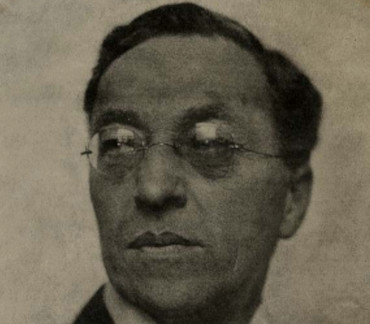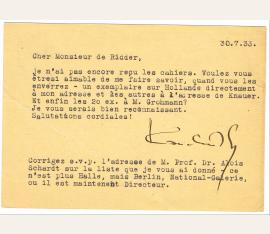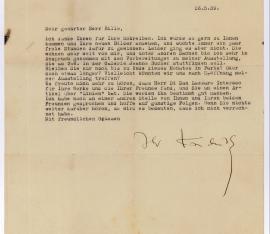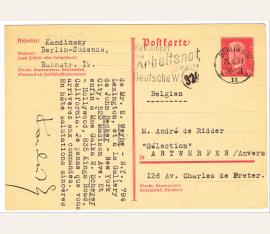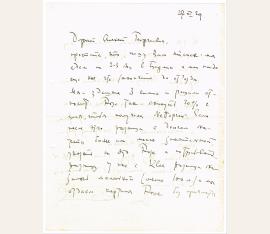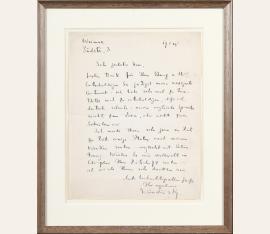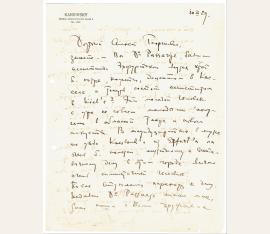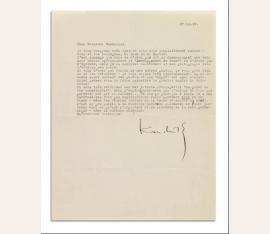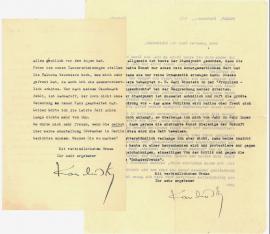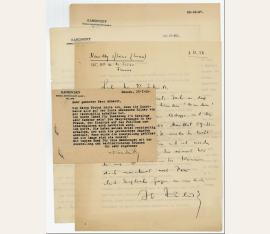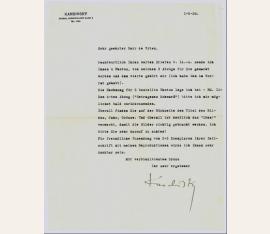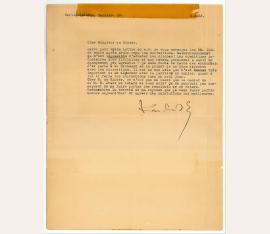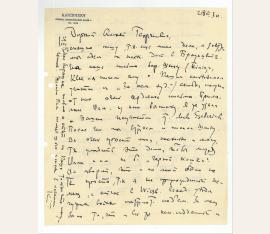painter (1866–1944). Typed postcard signed. Berlin. 8vo. 1 p.
$ 4,809 / 4.500 €
(25774)
Letter to André de Ridder in Anvers requesting copies of the issue of "Selection" devoted to his Art: "je n'ai pas encore recu les cahiers. Voulez vous etresi aimable de me faire savoir, quand vous les enverrez - un exemplaire sur Hollande directement à mon adresse et les autres à l'adresse de Knauer. Et enfin les 20 ex. à M. Grohmann?" - André de Ridder was the editor of the Belgian periodical "Selection," which published a special issue on Kandinsky in July 1933 ("Selection Chronique de la Vie Artisque XIV Wassily Kandinsky - Editions Selection Anvers 1933"). Will Grohmann was an important art critic and author of a book on Kandinsky and a contributor to the issue of "Selection."
Maler (1866–1944). Typed letter signed („Ihr Kandinsky“). [Paris]. ¾ S. 4to. Mit einer Beilage (s. u.).
$ 4,809 / 4.500 €
(26102)
To the Danish painter Ejler Bille (1910–2004), regrets to be unable to come and see his correspondent’s new drawings, reports some news from his exhibition, and is pleased that Bille had been asked to write an article on „lines“. – Minor traces of folding, and with some small damage to edges; together with an autogr. lettercard from Bille (Örby near Vejby, December 1, 1973. Oblong 8vo. 1 p.) and some newspaper clippings.
Russian painter and art theorist (1866–1944). Typed postcard signed („Kandinsky“). Berlin. (Oblong)8vo. 2 pp. With typed address.
$ 6,946 / 6.500 €
(44546)
To Andre de Ridder, a Belgian art critic and strong supporter of Expressionism, whose periodical ‚Selection’ published a special Kandinsky issue in July of 1933: „Je m’presse de vous dire que j’ai envoié les epreuves à M. Grohmann. Je vous prie bien de lui faire envoyer le plus tôt possible la correction des textes. Il faudra donc qu’il fasse l’ordre des pages. Vous m’enverrez peut être aussi la correction des textes – je vous serrais reconnaissant. Il faudra couper les rands du cliché ‚Komposition 4’.
Vous le ferrez sur l’épreuve de cette toile (les rands n’appartient pas au tableau!). Ne l’oubliez pas s. v. b.! Ayez la complaisance de faire envyoer un exemplaire du cahier immédiatement après la parition à M. Zervos: il voulait faire une notice sur ce cahier dans le prochain Cahier de sa Revue. Je regrette que les reproductions des grandes toiles (‚Komposition 4’ et ‚Komp. 6’) sont si petites: Komp. 6 a trois métres de longeur! [...]“. – As critic Andre de Ridder prepared the July 1933 Kandinsky issue of his periodical ‚Selection’, the artist remained in Berlin to wrap up business as the Bauhaus closed. Facing constant accusations of teaching ‚un-German, degenerate art’ and fostering Communism, the school could no longer function under the pressure of the Nazi Party. Kandinsky reviewed de Ridder’s pieces from afar and passed them along to his friend and future biographer Will Grohmann. Two decades after their creation, his Compositions continued to spark discussion; his abstract style of painting based on the nonrepresentational properties of color and form, intended to create the same emotional impact that music did, challenged the art world both theoretically and aesthetically. The artist requests that de Ridder send a copy to publisher Christian Zervos, and suggests contacting prominent gallery owners Erhard Weyhe and John Becker, along with Galka Scheyer, the American representative for Die Blaue Vier (a group of Bauhaus artists – Kandinsky, Klee, Jawlensky, and Feininger – who exhibited and lectured together) to secure orders. This letter, with an abundance of important references to modern art figures as well as its discussion of his famous Compositions, holds spectacular content regarding the groundbreaking artist’s life and career..
Russischer Maler u. Graphiker (1866-1944). Autograph letter signed. o. O. 2 Seiten. 4to.
$ 14,426 / 13.500 €
(59852)
To „Alexej Georgiewitsch“ Jawlensky member of the „Blue Four“: „Forgive me for writing to you in such a hurry; We are going to Berlin for two or three days, and I have to finish off a few things before we leave. We - the three Blues here - have decided on the following with regard to Rose: to reduce 20% of the price so that she receives the net price. If subsequently there turns out to be a more or less considerable difference still owing, to point this out to Rose and ask for this difference.
With Klee and myself this difference proved to be slight (less than 100 Marks), and we are giving Rose the pictures without any extra. I have already made arrangements for my painting to go off to him. Klee is busy with it too. In any case it is pleasant to finish with this matter. We also thought of the fact that our prices have risen in the meantime, so that the percentage added on does not make any difference […]“ – Kandinsky was one of Die Blaue Vier (Blue Four), formed in 1923 with Klee, Feininger and von Jawlensky, which lectured and exhibited in the United States in 1924. Due to right-wing hostility, the Bauhaus left Weimar and settled in Dessau in 1925. Following a Nazi smear campaign the Bauhaus left Dessau in 1932 for Berlin, until its dissolution in July 1933. Kandinsky then left Germany, settling in Paris..
Maler u. Graphiker (1866-1944). 2 autograph letters signed. Weimar. 4to (27,5:22 cm). Je 1 p.
$ 14,426 / 13.500 €
(61481)
To the German-born British portrait, travel, and topographic photographer Emil Otto Hoppé in London, notifying that he will send some pictures of his work from time to time (June 19), and sending „1 photograph and 7 prints“ (June 23). - Hoppé ran his own photo studio in London and is considered one of the most important portrait photographers of his time; he also worked as an art editor for magazines such as Artwork, Color and Vogue. - Traces of folding, slightly wrinkled. Framed.
russischer Maler, Grafiker und Kunsttheoretiker (1866-1944). Eigenhändiger Brief mit Unterschrift. Dessau. Gr.-4to. 2 pp. Gestempelte Adresse. Gelocht. Russisch.
$ 10,152 / 9.500 €
(83319)
An Alexej Georgijewitsch Jawlensky (1865-1941). Kandinsky erinnert ihn an einen jungen Mann, der als Assistent im Museum in Erfurt, später als Dozent in Kassel arbeitete und jetzt als Assistent in Kiel ist. Der junge Mann sei zwar jung, hat aber erwachsene Gedanken über Theater und moderne Kunst. Kandinsky bittet Jawlensky mit wichtigen Menschen in Wiesbaden, wo er selber zu Besuch war, sich für diesen jungen Mann einzusetzen und ihn als Direktor des Museums vorzuschlagen, weil er eine richtige Wahl für Modernisten wäre. Jawlensky zählt als Maler des Expressionismus zum Umfeld der von Wassily Kandinsky und Franz Marc initiierten Künstlergemeinschaft Der Blaue Reiter.
Russian painter and art theorist (1866-1944). Typed Letter Signed ("Kandinsky"). N. p. 4to. ½ p.
$ 10,152 / 9.500 €
(48383/BN30824)
To "Dear Mr. Nicholson", agreeing with him and his colleagues Messrs. Gabo and Martin, promising to send a photograph of his work "Developpement en brun," requesting that the other photos be returned, asking when the first issue of the magazine is expected, expressing interest in an essay entitled "Constructive Point of View," and objecting that the author might too readily associate: "[...] Si vous m'avez pas besoin de mes autres photos, je vous prie bien de me les retourner - je vous serais très reconnaissant. On me demande assez souvent des photos et mon 'dépot' est as[s]ez modeste. Quand pensez vous de faire parraitre le premier numéro de votre revue? [...]". - Folds.
Maler (1866-1944). 2 typed letters signed ("Kandinsky"). Dessau. Zusammen 4 SS. auf 2 Bll. 4to und 8vo. Mit 2 eh. adr. Kuverts.
$ 10,152 / 9.500 €
(47577/BN32238)
To John Schikowski (1867-1934), editor of the Berlin magazine "Vorwärts", about hostility toward abstract art: "Various opponents who remained silent for several years have become courageous again by various processes and are happy about the almost universal reaction that overwhelmed the arts. But mostly they are happy because they can again write about the arts in their ancient, superficial tone [...] The attitude that abstract art has value merely as arts and crafts and can produce only pure ornamentation has become the received point of view.
The latter, for example, was claimed by Carl Einstein in the 'Propylaea Art History' where he discussed my work [...]" (15 May 1926; transl.). In his letter of 13 October, Kandinsky discusses Schikowski's book on modern dance in detail. - At the time John Schikowski was considered one of the best critics of modern art and modern dance..
Maler (1866-1944). 3 (1 autogr. and 2 typed) letters and 1 autogr. postcard, all signed ("Kandinsky"). Dessau und Neuilly-sur-Seine. 4 SS. auf 3 Bll. (Briefe) und 1 S. auf 1 Bl. (Karte). Gr.-4to und qu.-8vo.
$ 16,029 / 15.000 €
(47578/BN32239)
Fine letters to Georg Schmidt (1896-1965), who was operating from 1927 to 1938 as librarian at the Basel Trade Museum and, at that time (1927), organized an exhibition of paintings by August Babberger, Arnold Brügger, Hanns Joerin, Otto Morach, and Wassily Kandinsky. In his early letters, Kandinsky discusses some details of organizing this exhibition.
Maler (1866-1944). Typed letter signed ("Kandinsky"). Dessau. 01.05.1928. 1 S. 4to. Mit gestempeltem Briefkopf und dem dazugehörigen Kuvert. Dazu 3 Photographien von Lucia Moholy u. a. (s. u.).
$ 10,152 / 9.500 €
(47579/BN32240)
To art historian R. W. P. de Vries in Hilversum, sending four photographs for publication ("3 of which were made for you and the fourth belongs to me, I've had it in stock"; transl. from the German original). - Three of the four mentioned photos (all with the photographer's stamp on their reverse) belong to "Einige Kreise 1926", "Spannung in Rot 1926", and "Akzent im Rosa 1926"; the fourth picture seems to be returned as Kandinsky has asked to do so. - Additional addenda comprises a copy of "Der Sturm" (vol.
III, October 1912, no. 129), in which Kandinsky's long essay "Ueber Kunstverstehen" ("On Understanding Art") was published, 4 newspaper clippings with reviews of his exhibition at the gallery "L'Époque" in Bruxelles, and another contemp. photo of a painting by Kandinsky..
Russian painter and art theorist (1866-1944). Typed letter signed. In French. Berlin-Südende. 08.06.1933. 4to. ½ p.
$ 6,946 / 6.500 €
(80859/BN52738)
To the Belgian art historian and editor of the periodical "Sélection" André de Ridder (1888-1961), concerning payments and photographs for a forthcoming issue devoted to Kandinsky: "I will send you the 200 Reichsmark as soon as I have received the corrections. Unfortunately, it's impossible for me to buy the negatives!". Kandinsky hints at his dire financial situation due to the forced closure of the Bauhaus by the Nazis since April 1933 which led to its ultimate dissolution on 19 July: "The financial conditions are difficult and my personal income has undergone an unpleasant change - I am forced to save money." He also mentions that his friend, the important art critic Will Grohmann would finish the corrections for the issue within a day: "I have spoken to Mr.
Grohmann and asked him to hurry up with the corrections. In my opinion, it is very important to hurry up with the corrections. As for him, he will make the corrections in only one day." In closing, Kandinsky underlines that a two month delay caused by another publication wasn't his fault so he shouldn't have to bear the consequences and apologizes for the scant response: "Dear M. de Ridder, it's not my fault that the notebooks of M. W. [Edward Wadsworth] had a two month delay! It wouldn't be consequential to make me bear the results of this delay. Please excuse the scantness of my response [...]". - The special issue entitled "Sélection Chronique de la Vie Artisque XIV Wassily Kandinsky - Éditions Sélection Anvers 1933" appeared in July when Kandinsky and his wife were about to move to Paris, fleeing the Nazi regime. - With an adhesive mark on the upper edge, folded, and slightly browned..
Russian painter and art theorist (1866-1944). Autograph letter signed. Dessau. 28.03.1930. Folio. 2 pp.
$ 13,358 / 12.500 €
(82593/BN53775)
Letter in Russian to Alexej von Jawlensky (1864-1941) concerning the preparation of the exhibition "30 deutsche Maler aus unserer Zeit" which would be held from April to July 1930 at the "Nassauischer Kunstverein" in Wiesbaden. - Kandinsky explains that despite his difficulties in communicating with the Germans, not being German himself, he managed to get Jawlensky to present seven paintings there. He pointed out to him that he should not be disappointed because it was more than for most of the other participants, and asked him not to be angry with him since the decision was not up to him.
Kandinsky also writes about the two other members of the exhibition group "The Blue Four", which he founded with Jawlensky in 1924: Paul Klee and Lyonel Feininger. - Left margin with punched holes (no loss to text)..
sold
E. Brief mit U.
Autograph ist nicht mehr verfügbar
Wassily Kandinsky (1866–1944), Maler. E. Brief mit U. („Kandinsky“). München, 8. Mai 1914. 3¾ SS. auf 2 Bll. 4°. – An den Sammler van Assendelft: „Es freut mich zu hören, daß Sie im Juni nach München kommen. Ich bin dann entweder hier, oder auf dem Lande. Wenn Sie mir rechtzeitig eine Karte schreiben, komme ich mit besonderem Vergnügen in die Stadt. Adresse ist Murnau a. Staffelsee, Oberbayern. Übrigens werden mir die Briefe nachgesandt, so daß Sie auch an meine Münchner Adresse schreiben können. Es ist mir ziemlich schwer, in abstrakteren und abstrakten Sachen ganz objektiv zu bleiben. Hier hat sich in mir eine eigene Welt gebildet, die aus vibrierenden Formen besteht. So erscheinen mir die Formen, die sich den geometrischen nähern, müde [?], gerade Konturen aufweisen, ziemlich fremd. Ihre Sprache ist für mein Ohr zu trocken, ihre Pulsierung – mechanisch. Deshalb lassen mich die meisten kubistischen Arbeiten vollkommen kalt und diese Kälte empfinde ich auch in den Linoleumschnitten [...] Den Eindruck, daß diese Sachen nicht entstanden sind, sondern gemacht wurden, kann ich nicht loswerden. Wenn die Ausstellung hier ist und [ich] viel mehr zu sehen bekomme, so ändert sich vielleicht dieser erste Eindruck. Über die Frage, ob die Kunst gemacht werden kann, habe ich viel nachgedacht. Manche Maler von heute haben mir diese Frage aufgezwungen. Nun bin ich zum Schluß doch zu der Meinung gekommen, daß auch die kühlste Kunst im Künstler entsteht und er findet nur die passende Form. Aber auch dieses unbedingt unter Mithilfe der reinen Intuition [...]“. – S. 1 mit Adreßstempel. - Bei Kriegsausbruch 1914 musste Kandinsky Deutschland verlassen und kehrte nach Russland zurück. - So frühe und inhaltsreiche Briefe Kandinskys sind äußerst selten.
Brief m. e. U.
Autograph ist nicht mehr verfügbar
Wassily Kandinsky (1866–1944), Maler. Ms. Brief mit e. U. („Kandinsky“). Berlin, 30. Mai 1933. ½ S. Gr.-4°. – An Monsieur Ridder über pkpk: „pkpk“. – Mit kleinen Läsuren am linken Rand, dort auch etwas gebräunt; beiliegend ein großformatiges Portrait des Malers (einer Monographie bzw. einem Werkverzeichnis entnommen).
E. Brief mit U.
Autograph ist nicht mehr verfügbar
Wassily Kandinsky (1866–1944), painter. ALS. Pörtschach, 1 August 1927, 2 pp. 4°. Punched holes restored. In German. To one Mr. Probst: “[...] The address of the Paris salon is: Granoff Gallery, Blvd. Haussmann. This gallery is run by a Russian lady who shows primarily Russian collections. Of course, the issue of the transportation costs is not a simple one in the case of my collection. Would you please be so kind to make inquiries there. In Paris, the press is extremely important; the gallery shall supply them with ample material. The second address is: Prof. Anton Matejcek Praha II, Havlicek Square. One could only ask him which opportunities he sees for exhibiting in Prague. As he is director of a museum, it might be possible to exhibit in the museum. But I do not know whether there are rooms available there. Part of my collection is still in the Hague, as Gottschalk hadn’t yet finished negotiations with Antwerp and another place. He wrote me that the Van Gogh collector in the Hague, Ms. Kröller [?], was interested in my exhibition but then had to leave town for a short period. This for your information [...]”. – Slightly browned.
